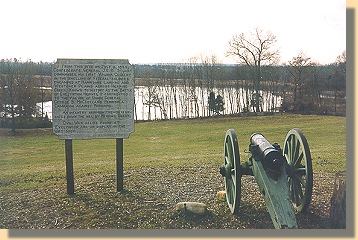The Golden Opportunity at Evelynton Heights
Exactly one year before the Battle of Gettysburg Confederate James Ewell Brown “JEB” Stuart made possibly an even costlier mistake. He lost Evelynton Heights.
Evelynton is the name attributed to both the plantation home of the Ruffin family (the same family that Edmund Ruffin, who fired the first shot in the Civil War, belonged to) and of a slight rise of land near the James River.

According to historian Clint Johnson, it was here that General “JEB” Stuart lost a golden opportunity (81). Laid out below the heights, around Harrison Landing was the bloodied, hungry, and tired Army of the Potomac under the command of General George B. McClellan. The Seven Day’s Campaign had just ended and McClellan and his tired army were huddled here at his base on the James River.
And that is where General Stuart saw from the heights of Evelynton that morning. During the night of July 2nd, Captain John Pelham, in charge of Stuart’s Horse Artillery, sent word back to his chief of the advantage of taking Evelynton Heights. Stuart, according to his official report “forwarded his [Pelham’s report] to the commanding general through General [Stonewall] Jackson and proceeded at once to the ground with my command.”
What he found was “a plateau commanding completely the enemy’s encampment.” Even more promising he found the heights “easily gained” as an enemy squadron “vacated without much hesitation.”
If the news could not get any better, Stuart learned from prisoners that “the enemy’s main body was there, but much reduced and demoralized.”
 Artillery piece marks the spot where Pelham’s Horse Artillery went into action on July 3, 1862 at Evelynton Heights. (Photo courtesy of U.S. Civil War Photographs http://www.usa-civil-war.com/Civil_War/evelynton.html)
Artillery piece marks the spot where Pelham’s Horse Artillery went into action on July 3, 1862 at Evelynton Heights. (Photo courtesy of U.S. Civil War Photographs http://www.usa-civil-war.com/Civil_War/evelynton.html)
Unfortunately for Stuart, his quick movement to follow up on Pelham’s report distanced him, according to historian Clint Johnson, “at least 10 miles” from his closest infantry support (82). Furthermore, by “sending the Union cavalry packing” he had warned the Federals of a Confederate presence in the area (82). Another mistake, Johnson argues, was ordering Pelham to begin firing a “single six-pounder howitzer on the Union forces” (82).
Stuart did not see the error of ordering Pelham to begin his one-gun barrage but simply reported that had Longstreet not “taken the wrong road” and was “6 or 7 miles off” the affiar might have ended differently. Instead the Union army, alerted to the importance of the heights at Evelynton moved to take possession of the plateau. Stuart and his outnumbered cavalry and artillerists were ceded the heights and the Union army secured their encampment at Harrison’s Landing.
Jackson and Longstreet arrived with their infantry in time to do a quick survey of the Federal defensive works and rightly surmised that they were too formidable to attack.
Thus, a golden opportunity to severely cripple McClellan’s army before it could recuperate was lost.
Yet, it is interesting to speculate what could have happened. If Lee was made aware of the opportunity at Evelynton Heights is not certain. Could one venture a guess that if he was he would have pushed for the chance to destroy the Union army, as he had tried in vain since he opened the Seven Day’s Campaign?
Up against the river, with no where to run, how would McClellan and his army respond? If in the demoralized state that the Union prisoners reported it as, Lee could have caused serious harm. He might have had the complete battlefield victory he desired. Or would the gunboats be able to protect McClellan’s army?
We will never know the answer to these questions; but like at Glendale, the chance at Evelynton Heights was another missed opportunity of the Seven Day’s Campaign. The chance was lost–maybe it was Stuart’s fault or maybe it was the infantry’s fault–either way the Confederacy could not afford to miss a golden opportunity to crush an opposing enemy army and send shock waves through the Union war effort. Evelynton Heights presented one of those rare opportunities.
Notes:
According to James River Plantation Tourist Guide (www.jamesriverplantations.org) Evelynton Plantation is currently closed to the public. There is a marker and the canon still on the heights that one can go visit. Here is information on that marker: http://www.markerhistory.com/evelynton-marker-v-22/
Good article, but I respectfully disagree with the conclusion that it was a lost opportunity. McClellan’s army was well under the protection of its gunboats and had superior artillery; I seriously doubt that any Confederate attack would have pried him from his position.